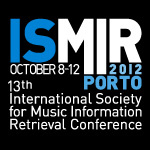~ ISMIR 2012 - Highlights
» By Joren on Monday 08 October 2012 The 13th International Society for Music Information Retrieval Conference took place in Porto, Portugal, October 8th-12th, 2012. This text contains links to some papers, toolkits, software presented there which are interesting for my research. Basically it contains my personal highlights of the conference. The ISMIR 2012 is described as follows:
The 13th International Society for Music Information Retrieval Conference took place in Porto, Portugal, October 8th-12th, 2012. This text contains links to some papers, toolkits, software presented there which are interesting for my research. Basically it contains my personal highlights of the conference. The ISMIR 2012 is described as follows:
The annual Conference of the International Society for Music Information Retrieval (ISMIR) is the world’s leading research forum on processing, searching, organizing and accessing music-related data. The revolution in music distribution and storage brought about by digital technology has fueled tremendous research activities and interests in academia as well as in industry. The ISMIR Conference reflects this rapid development by providing a meeting place for the discussion of MIR-related research, developments, methods, tools and experimental results. Its main goal is to foster multidisciplinary exchange by bringing together researchers and developers, educators and librarians, as well as students and professional users.
Tutorials
I saw an interesting tutorial on Jazz music and a tutorial on source separation. After an introduction, which detailed the experimental basis of the system, a source separator was introduced. The REPET source separator is a relatively simple system that yields reasonable results to split accompaniment from foreground melody.
Posters & Talks
The approach and the dataset used in N-gram Based Statistical Makam Detection on Makam Music in Turkey Using Symbolic Data is very interesting. More than 800 pieces of makam music where transcribed manually and analysed. Details about the dataset are available in the following paper: A Turkish Makam Music Symbolic Database for Music Information Retrieval: SymbTr.
Assigning a Confidence Threshold on Automatic Beat Annotation in Large Datasets by Zapata et al. shows a very interesting way to do exactly what the title says. Descriptive titles are descriptive.
A very practical tool to do melody extraction was presented by Justin Salamon. He created a Vamp Plugin with the name Melodia. Unfortunately the plugin is currently only available for windows, but Linux and OS X versions are in the pipeline. More about the algorithm implemented and background information can be found in the paper Justin presented: Statistical Characterisation of Melodic Pitch Contours and its Application for Melody Extraction. Another Vamp Plugin for melody visualization was also presented: Pitch Content Visualization Tools for Music Performance Analysis.
The ongoing work by Ceril Bohak and Matija Marolt on segmentation of folk music could be very useful to apply on Afican musics. The paper is called Finding Repeating Stanzas in Folk Songs.
